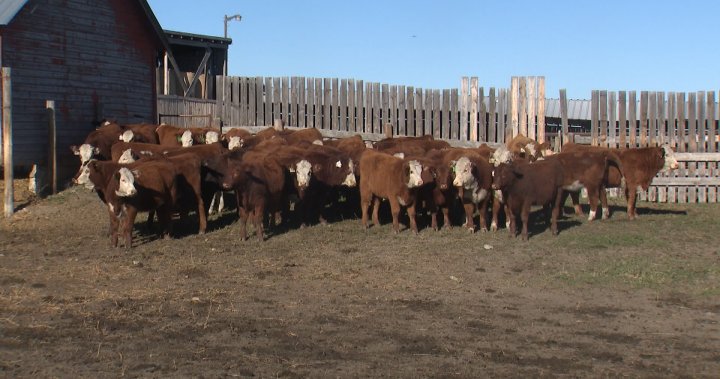Shortage of cattle behind recent jump in beef prices, industry says
If you’re a fan of Canadian beef, you’ve probably noticed that juicy steak on your plate has forced you to dig deeper into your pocket to pay for these days.
That’s because, according to industry insiders, the size of the cattle herds in this country is at a 40-year low.
“There’s a lack of cattle in the industry, so there’s a bit of a shortage which is going to cause that bump in price,” said Brandon Ball, butcher and owner of Brant Lake Wagu in Calgary.
It’s a case of “supply and demand,” said Ball. “It’s pretty much everything across the board.”
Describing his business as “a complete pasture to plate program — we own the animals, we feed them, we process them,” Ball’s butcher shop offers everything from a $10 to a $200 steak.
Brandon Ball, owner of Brant Lake Wagu in Calgary, says the increasing cost of beef is a simple case of supply struggling to keep up with demand.
Global News

Ball said the shortage of cattle is forcing butchers to utilize every part of the animal.

Get weekly health news
Receive the latest medical news and health information delivered to you every Sunday.
“We’re finding different muscles that have different uses, different tendernesses — anywhere from your typical rib eye, strip loin, tenderloin, we have some unique cuts like picanha, bavete steak, denver steak, zabuton,” Ball said.
“There’s a lot of steaks that customers have never tried before.”
Brandon Ball, and owner of Brant Lake Wagu in Calgary, says despite the increasing cost, consumers are willing to pay a bit more to put good quality Canadian beef on their plates.
Global News
The Canadian Cattle Association (Canfax) said there are a number of reasons behind the decline in the size of Canadian cattle herds.
“Our cattle inventory has declined for a number of years. It’s actually the lowest since the mid-’80s,” said market analyst Jamie Kerr.
“A lot of those (reasons) are weather driven and there have been negative margins (losses) guys have seen for a number of years in a row, which has discouraged some producers and some have gone out for those reasons,” explained Kerr.
He says the average age of beef producers is getting older, too. “As a producer gets out, the family doesn’t want to take over and so there’s some some bleeding out of the industry that way.”
Kerr is confident the supply will eventually increase to better meet demand, but that could take a couple years.
“I would say one to two more years of reduced cattle numbers. We are starting to see the cycle move into a period of consolidation, which means that we may be at the bottom of the cattle inventory cycle and on our way back up,” added Kerr.
Jamie Kerr, a market analyst with the Canadian Cattle Association, is confident that the size of the country’s cattle herd will eventually increase to meet demand, but that could take from 1 to 2 years.
Global News
For consumers that means no short-term relief from the higher prices. “We’re still two or two-and-a-half years away from seeing any increase in beef production simply due to the lagged effect of of the reproductive system of cattle,” added Kerr.
Despite the higher prices, Kerr said, “Canadians are still looking to put Canadian beef on their plates.”
That’s something Ball is noticing at his butcher shop, too — consumers are willing to pay at bit more for good quality Canadian beef.
“They want good (quality),” said Ball. “More people are looking for local. If they’re going to spend that money they want to have the quality that goes with it.”
© 2024 Global News, a division of Corus Entertainment Inc.


